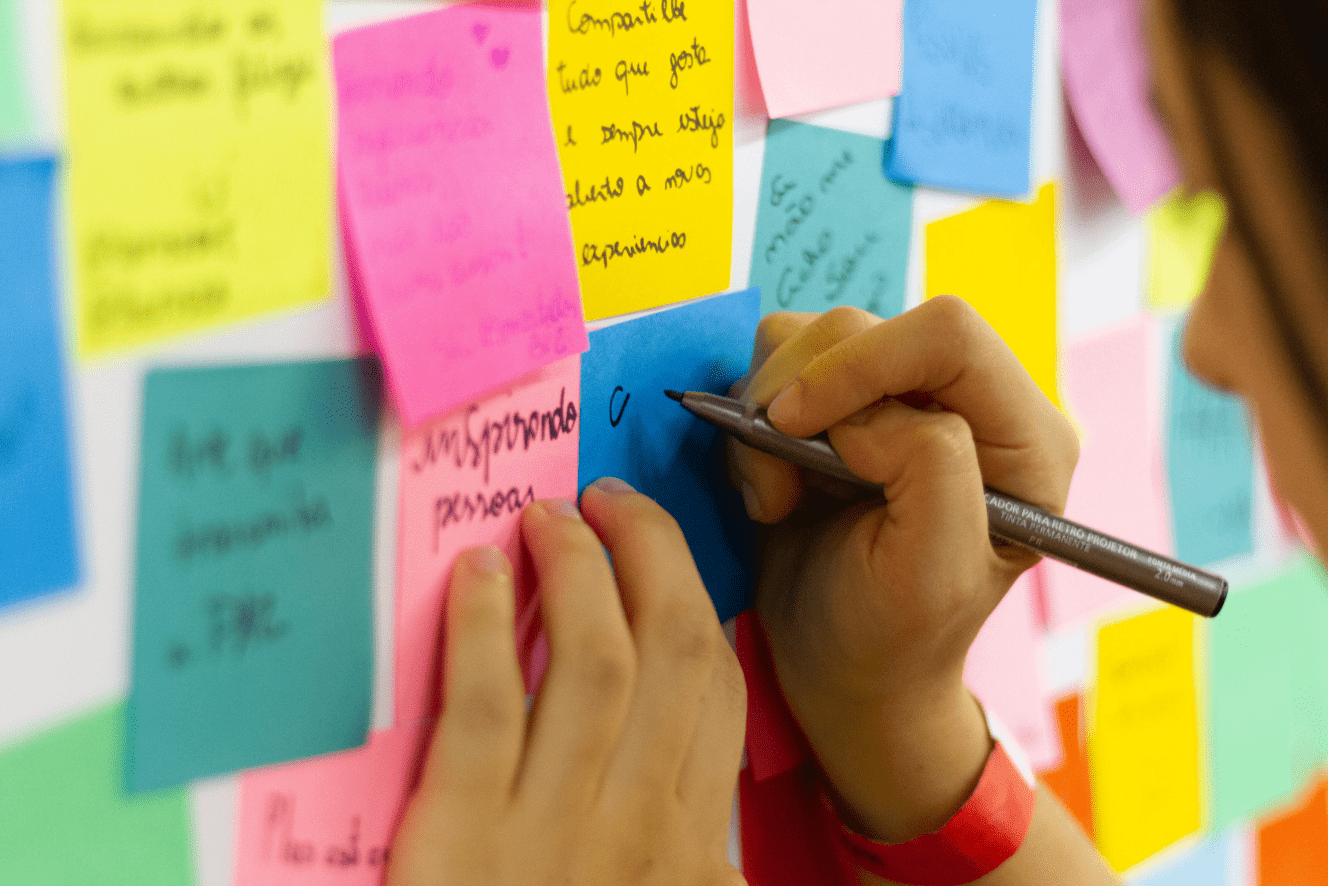Working memory is a mental skill that helps your child to work with information over short durations.
It facilitates the retention of re-usable information during ‘an ongoing’ cognitive activity such as a conversation, cooking, or reading.
Think of working memory as a display board in the brain where your child posts sticky notes containing important words and sketches.
These remind him of the circumstances around a task he is performing, i.e., responding to a question, and therefore, not forgetting the question he was asked a few moments back!
One relies on working memory to retain the partial results while solving an arithmetic problem without paper, … or to bake a cake without making the unfortunate mistake of adding the same ingredient twice.
NCBI
Your child’s working memory is certainly poor if he keeps forgetting the names of people he is introduced to. The same is true if he enters the bedroom to pick a shirt and somehow comes out with a belt!
There are other reasons why working memory is important.
It has been argued that the skill is the foundation of reasoning and intelligence, arguably more reliable than IQ and test scores:
Those who can hold many items in their mind may be well equipped to consider different angles of a complex problem simultaneously.
APA
Working memory is often used interchangeably with short term memory to mean the same thing. The two are, however, not exactly the same.
While short-term memory strictly refers to the short-term storage of information, working memory refers to short-term storage in addition to real-time cognitive processes taking place in the brain.
Working memory and other mental skills
Working memory is only one of the three mental skills collectively known as executive functioning skills. The others are self-control and flexible thinking.
The three are important higher-level mental skills necessary for managing and controlling tasks, actions, behavior, and emotions.
Children are not born with these skills, but rather, they learn them during childhood and continue to do so as they age.
The experiences they go through in the environment and what they learn from parents, educators, and others in the community are helpful in shaping the development of executive functions.
Exercises to boost working memory

If your child has challenges retaining cognitive information, the following DIY exercises may just be what you need:
1. Teach focus and attention
The ability to focus and mentally attend to tasks allows your child to filter out distractions and other shortcomings in memory.
One way to teach focus and attention involves letting your child know the values of sticking to routines, and therefore completing one task before shifting to another. This is in addition to completing tasks in time.
Become a working memory role model by following through with your routines and completing tasks on time.
Simple exercises such as going to bed and waking up at the same time every day are good starting points.
Elsewhere, enforcing discipline and etiquette during mealtimes and other scheduled events teaches your child to attend to tasks correctly. They should respect homework time and screen time rules.
Yes, interruptions and distractions are necessary burdens in life, and your child must learn to juggle multiple tasks while remaining focused.
Interruptions such as a phone ringing or peers playing outdoors can interfere with your child’s ability to recall and stick to real-time responses.
Let your child know that the task at hand is more important than the distractions elsewhere.
Disruptions should be minimized at the beginning, but your child must learn to multitask as he grows up. Disruptions are integral to life and will always remain so.
2. Encourage your child to visualize
Teach your child to always create a picture in his mind of the tasks at hand. The visual construction of ongoing cognitive activities guarantees that information stays in the brain for long durations.
unless our words, concepts, ideas are hooked onto an image, they will go in one ear, sail through the brain, and go out the other ear.
Lynell Burmak
To make this point clear you can experiment with many visualization tasks. For example, you can place a stuffed animal in a bag and let your child feel the animal by putting the hand in the bag.
Through touching and creating an image of what he is feeling in the bag, your child should be able to name the hidden animal he is touching.
Elsewhere, if you send your child to bring an umbrella from the house, let him draw its picture in the brain and visualize its usual location before dashing out wildly.
You can also have your child draw a map of the world after showing him a picture of the globe. Withdraw the globe and have him draw what he has seen.
Drawing can be done on paper and on the computer.
Poetry is another interesting area that can help enhance active memory, as illustrated by This Reading Mama.
3. Make learning simple
While the atmosphere and environment at home and school should always be friendly, the tasks assigned to children should be simple to understand and implement.
For example, your child’s working memory should not be taxed to the extent that comprehension becomes a problem.
In the following sentence, comprehension is hard both for children and adults:
It is said that, if your work is not overwhelming, your car is in good repair, and the leaves have changed color, it is a good time for a fall vacation.
NCBI
Yet the sentence can make better sense if said differently:
It is said that a good time for a fall vacation is when your work is not overwhelming, your car is in good repair, and the leaves have changed color.
NCBI
Elsewhere, break down information and tasks into smaller chunks. For example, instead of sending your kid to collect five items at a time, let him collect one or two at a time.
With age and experience, your child will develop the ability to store multiple tasks in the brain without trying so hard.
4. Tell stories and experiences to hack your child’s memory
Telling stories and talking about past experiences are sure ways to build your child’s working memory and long-term memory.
Stories and experiences in life will encourage your child to think in context. Then he can predict what is going to happen next in the narrative.
Your child will take great pleasure in predicting the course of the story, and getting it right.
Tell interesting stories from your past and make sure your child is paying attention and following your narratives.
When your child listens to stories, he learns to connect the different dots and plots in the story, while reflecting on them in the present environment.
Your child can also tell stories of his favorite trips to the park, a tour of a new town, or a safari back in the country where grandees live.
You can even have them visualize these memories and write or draw them on paper or on the computer.
In the classroom, teachers can also improve working and other memories by telling stories of great scientists before introducing new and related concepts in the class.
5. Encourage indoor and outdoor exploration
Involve your child in house chores to help him learn how to multitask without forgetting ongoing tasks. The more tasks a child does at different times of the day, the more he learns to pay attention and switch focus.
You can also make it a habit to explore the outdoors with your child to stimulate the four senses in order to become receptive to new life experiences.
While walking outdoors ask questions related to the environment. Ask your child to identify flowers, trees, animals, and let him know how to interact with them.
Discuss what plants and animals are safe and which ones are not, and repeat these instructions every once in a while.
Discuss the discoveries of the day when you get back home to find out how much information your child remembers. You can have him write down or draw images of the day’s findings.
The prospect of venturing outdoors stimulates the 4 happy chemicals and will sharpen the desire to explore the outdoors.
6. Allow your child to play
Board and other indoor games charge up memory retention simply because the brain is always at work figuring new strategies and winning tweaks.
Children are challenged to remember the rules of the game, and guess opponents’ arsenal and cards.
One way involves playing number and letter games where your child reads sequences of numbers and other short details backward. These can be telephone numbers, number-plates, etc.
You can also have the child recall the 2nd or other letters in text sequences. Intensive games also help children to master focus and attention.
Reading can be done at the family level, at school, and in private. You can start by reading aloud as your child listens and comprehends the reading skill.
7. Encourage your child to read and write
By reading wide, your child can learn to absorb a lot of information and remember the story told in the books he reads.
When you read aloud, your child is subconsciously trained to follow the story and recall the different plots being told.
With time, your child will learn to read on his own and understand the literature you provide. Collect and purchase a variety of interesting literature to read.
Besides boosting long-term memory, reading encourages your child to ask questions and discuss what is told in the books.
Besides reading allow your child to learn how to write. By writing, your child uses short-term, long-term and working memories, to transfer what is in the brain onto the paper.
Writing should not be limited to papers only. Your child can write using word processing applications on the computer.
8. Make lessons creative and interactive
Monotony affects how your child will approach ‘new’ learning experiences. The more he does the same thing every day, the less he will develop the interest and motivation to continue.
At school, creative teachers can eliminate boredom by using enjoyable and flexible teaching experiences. They can use audio-visual teaching materials, pictures, flashcards, and outdoor learning.
By varying teaching methodologies, in the classroom, your child will be expectant of the next lesson and new concepts. This is a sure way to excite the working memory in the brain.
9. Connecting the dots
By connecting the dots, you allow your child to listen, ask, give suggestions, and fully participate in the tasks given. This is better than having your child walk blindly through learning experiences.
Connecting the dots of the activities your child is doing gives meaning to continuity and the reasons to try new tasks. In any case, the brain uses lessons learned in the past to understand new experiences.
Better still, the brain makes better use of short-term memory and transfers learned lessons to long-term memory.
10. Follow up
When you follow up on your child’s progress at home and in the classroom, only then will you get a picture of what needs to be done next. This is possible through planned homework or simple tests at the end of the lesson.
Make sure your child completes the tasks he receives and where he fails, talk to him and provide the necessary scaffolds to simplify tasks.
Elsewhere,
- talk face to face with your child
- look for any signs of memory overload
- try out different tasks in different environments
- encourage your child to have an open mind
Working memory disorders
It is not always a smooth road when teaching working memory to kids. Disruptions such as psycho-social stress can interrupt their learning abilities.
External factors such as ADHD, autism, poor sleep, anxiety, depression, and other health challenges can maim the ability in children to embrace the benefits of working memory.
When dealing with children affected by attention deficit disorder (ADHD) and other failings, it is important to break down instructions and tasks into smaller chunks.
Elsewhere, talk with your doctor and other medical professionals to lay down better learning strategies for your child.





Leave a Reply